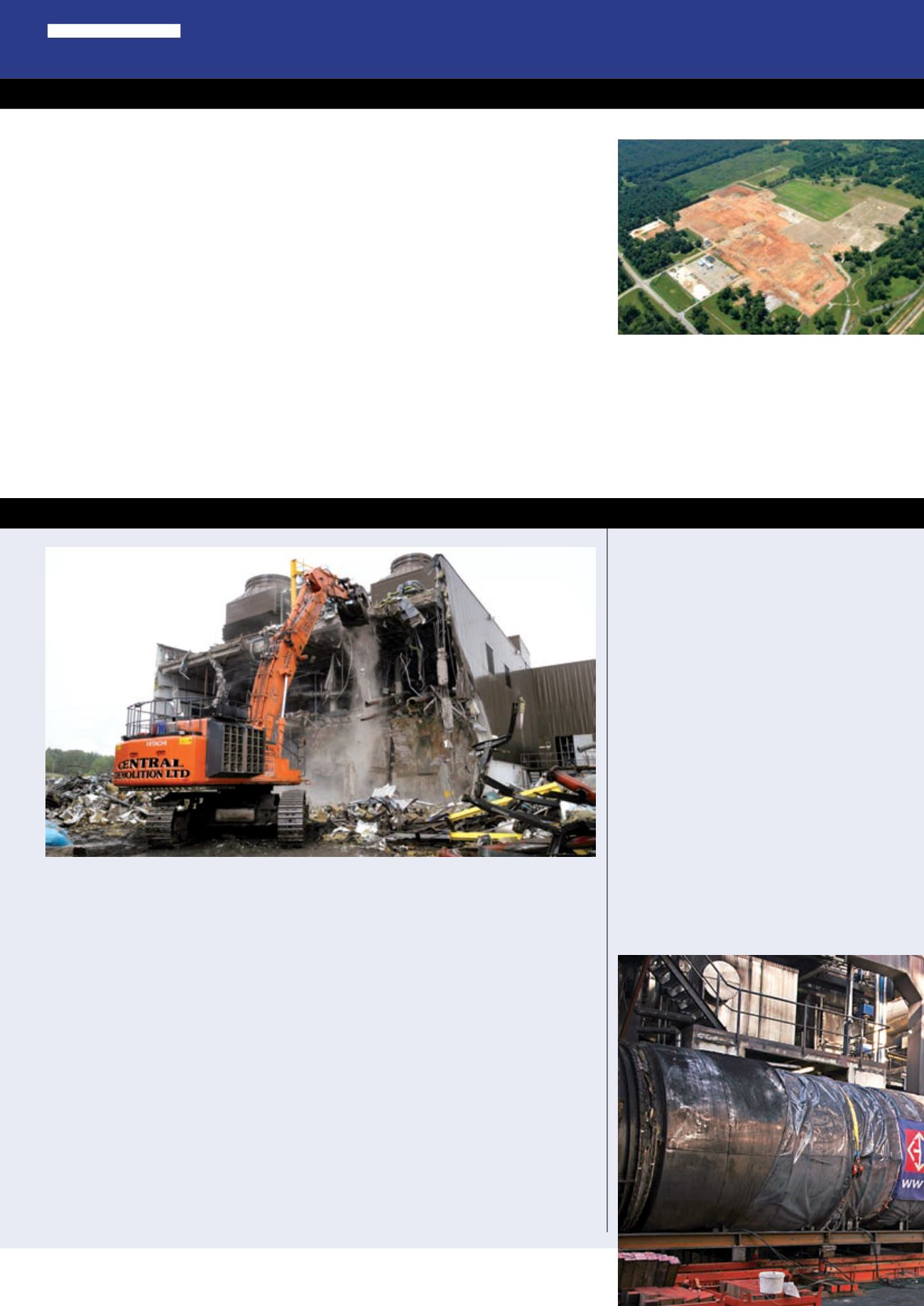
38
DEMOLITION AWARDS SUPPLEMENT 2014
d
&
ri
RECYCLING& ENVIRONMENTALAWARD
INDUSTRIALDEMOLITIONAWARD
Brandenburg Industrial ServiceCo.
Merck Flint River Plant,
Albany,Georgia
Brandenburgwas contracted to perform the
demolition, environmental remediation and asbestos
abatement of the 65,000m
2
(700,000 ft
2
) former
Merck Flint River Plant in Albany, Georgia, that began
production in 1952 and closed in 2007.
The first stepwas to implement environmental
and safety control methods designed to ensure the
safety of workers, the public and the environment. A
silt fence and gravel leaching systemwere installed
to ensure no contaminants left the property or entered
the Flint River.
The next stepwas to abate all environmental
hazards. The 100 acre site contained over 105,000
tonnes of contaminated concrete, blocking and
asphalt that was transported to local landfills using a
large fleet of trucks alongwith Brandenburg’s custom
engineered demolition trailers. All had to be properly
permitted and licensed to haul specific waste streams
- 500 tons of hazardousmaterial was delivered to
an incinerator in Texas, 5,000 tons of hazardous
material concrete wasmoved to Emelle in Alabama.
Several undocumented process lines full of a
hazardous product containing formaldehyde were
discovered. Brandenburg notified the owner and
formulated awork plan to safely drain and remove
these. All wastes were closelymonitored, tracked,
and properly documented. By identifying, testing,
and disposing of these contaminants, Brandenburg
eliminated the hazardous waste at this site.
Once abatement was completed, structures were
dismantled following optimal methods to segregate
thematerials. This phase included several multiple
story buildings, housing elevator shafts 15m (50 ft)
below ground, pipe racks, tank farms, offices, and
all underground utilities, foundations and basements.
There were 1,322 loads of scrap that generated
more than 13,500 tonnes of recyclablematerial.
Excavations of several 1.8m (6 ft) thick foundations
more than 9m (30 ft) deepwere removed.
The final stage was backfilling all excavations
caused by concrete removal. The project was
completedwithmore than 125,000man hours and
zero lost time accidents.
The assignment demonstrated significant
environmental conservation, community improvement
to health and safety, and a positive impact on the
quality of life.
Central Demolition
FreescaleMotorola facility,
East Kilbride, Scotland
Central Demolition has been shortlisted for thework it
carried out at the 75,000m
2
(800,000 ft
2
) Freescale
Motorola plant in East Kilbride, UK. The site contained
a large number of bespoke steel-framed buildings that
had been added over a period of yearswhere required
to facilitate expansion byMotorola and then by
Freescale. The biggest difficulties ensued from the fact
that none of the buildingswere of similar construction
or of consistent height or feature. This resulted in
individual risk assessments andmethodologies
having to be developed for each, with each removed
successfullywith no incidents or injuries occurring.
The demolitionworkwas further complicated
by the existence of a testing facility adjoining the
demolition site that houses highly sensitive testing
equipment that could not be compromised under any
circumstances. To prevent damage to the equipment
Central organised and implemented a vibration
monitoring programme that demonstrated that
DDMDemontageBV
Cabot BVcarbonblackplant,
Rotterdam, TheNetherlands
DDM had been taskedwith the removal of two large
dryers at the Rotterdam site where Cabot BV produces
carbon black. The dryers are being replaced, with
the new units already being fabricated on site.
Themethod of removing the old and placing back
the new dryers was the challenge. After months of
contemplation about the best method to do this,
Cabot contacted DDM.
With an initially small team consisting of a
cost and technical engineer DDM took on the job.
Themain priorities for the client were safety, short
turnaround, very tight spaces and theminimisation
of disturbance to the operational plant. Another big
issue would be lifts over live process equipment.
Cabot and DDMworked out a detailed plan to
replace the dryers and a lifting and rigging company
were brought in. These became part of the team
that DDM lead, with the company responsible for
fabrication of the new dryers also involved in the
background.
All possible hazards were listed by DDM’s HSEQ
acceptable vibration levelswere not breached.
The site required extensive remediation activity
to keep it safe at all times and tomake it suitable for
future redevelopment. The network of stainless steel
and plastic pipework carried residual risks despite
prior cleaning. Central flushed out and visually
checked all pipes for sags and possible sites of
hazardousmaterials/substances.
Another major hazardwas having towork around
the phased removal of high and low voltage cables
duringworks on site until the supply to the adjacent
building could be diverted. The lineswere clearly
marked out and pointed out to all employees during
their site inductions to avoid accidents and because
it was of paramount importance that power to the live
building on-sitewasmaintained at all times.
Another example of a significant hazardwas
ground contamination. Some of the pits andwork
areaswere found to be contaminatedwith oil. To
resolve this hazard, these areas of groundwere
removed separately and carefully, and segregated for
cleaning and remediation prior to recycling.
WORLD
DEMOLITION
AWARDS2O14


